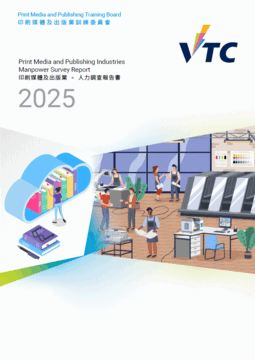Business Outlook
According to the World Economic Outlook Report published by the International Monetary Fund (IMF), the global economy was projected to grow by 3.2% in 2025. However, this growth remains subdued, with risks skewed to the downside, adding to global economic uncertainties. On the local front, Hong Kong’s Third Quarter Economic Report 2024 indicated that real GDP grew by 1.8% year-on-year in the third quarter, marking a slowdown from the previous quarter. Private consumption expenditure also declined by 1.3% compared to last quarter.
The industries remain concerned that stricter US trade policies, including those toward China, would impact enterprises with production lines in Mainland China and those engaged in re-export activities. However, given the prolonged Sino-US tensions, some Hong Kong-based companies with factories in Mainland China have already established new production lines in Southeast Asia. Many businesses are actively exploring alternative markets to mitigate the impacts of evolving US trade policies.
Record-high gold prices, coupled with rising costs of other raw materials and labour, have inevitably driven up product prices, dampening consumer sentiment.
Prolonged economic uncertainty has given rise to a new consumption norm. Many consumers who initially reduced spending to alleviate financial pressure have now turned it into a long-term habit, adopting a more strategic approach to their purchasing decisions.
All three industries are facing significant shortages of skilled production and repair technologists. Those experienced technologists who still serve the industries are approaching retirement age or being recruited by major brands while the influx of new talents is very limited. These together has created a widening competency gap, which is expected to worsen with upcoming retirements. Although there is a relatively stable supply of design talent, most emerging designers lack a thorough understanding of the production processes, making it difficult for them to fully consider the manufacturing constraints in their designs.
With an ageing global population, the “silver economy” is expanding, driving demand for reading glasses and health-monitoring devices. As for children and young people, myopia has emerged as a significant health issue among them. There is heightened health consciousness post-pandemic, presenting market opportunities for functional products across the Jewellery, Timepiece and Optical Industries. These include myopia control glasses, smart glasses with integrated photography and ChatGPT features, watches with wireless communication capabilities, and rings that track real-time health and fitness indicators.
Environmental, Social and Governance (ESG) has gained prominence in recent years. Consumers are more concerned about the sustainability of the products and their companies/brands. Factors such as product origins, environmental impact, and corporate stances on ethical and human rights issues would influence consumers’ purchasing decisions. Businesses proactively develop sustainable products that aligned with these values would successfully attract and engage this expanding consumer base.
Jewellery is gradually shifting from pure luxury items to everyday accessories. Technological advancements, such as the development of hard gold, have allowed manufacturers to craft delicate fine jewellery using lightweight 24K gold, making it more affordable.
Regarding the Timepiece Industry, the pre-owned luxury watch market has gained significant traction among collectors and younger consumers. Limited availability of sought-after models and discontinued pieces has fuelled demand, while competitive pricing has broadened market accessibility.
Similarly, for the Optical Industry, prescription glasses have evolved beyond their functional role. Many consumers now view them as fashionable accessories, matching them with outfits and hairstyles. It is common for individuals to possess multiple pairs, including non-prescription glasses that serve purely for style.
The Jewellery Industry is actively promoting standardised testing for Fei Cui to facilitate its expansion into international markets. Leading jewellery brands are leveraging blockchain technology to track the provenance of natural diamonds, enabling consumers to verify a diamond’s history from its source to the retail store, thus ensuring its authenticity.
In response to the growing market for smart wearables, the Hong Kong Productivity Council (HKPC) has established the Smart Wearables, Watch & Clock Technology Centre. The Centre offers testing services for traditional quartz and mechanical watches in line with international and Swiss standards, along with performance assessments for smart wearables that measure heart rates and blood pressure, for instances.
Furthermore, the introduction of Hong Kong’s Dealers in Precious Metals and Stones Registration Regime, which requires individuals involved in transactions of precious metals and stones exceeding HK$120,000 to register, not only reinforces anti-money laundering measures but also boosts overseas customers’ confidence when trading with local jewellers.
E-commerce opens up global market opportunities for businesses, allowing them to promote products internationally and connect with a broader customer base via internet and digital platforms. This approach not only expands sales channels but also enhances additional growth potential. Leveraging the internet and social media, businesses can quickly boost brand visibility through digital advertising and social media marketing. This could help attract target customers, strengthen brand image, and cultivate long-term customer relationships via effective online engagement.
Global sourcing has also shifted to a digital model. Recognising this trend, the Hong Kong Trade Development Council (HKTDC) has integrated online and offline components into international exhibitions held in Hong Kong. In addition to online product showcases, these hybrid events extend in-person networking and business discussions to a smart business matching platform, helping exhibitors overcome geographical barriers and connect with buyers all over the world.
In conclusion, similar to other industries, the Jewellery, Timepiece and Optical Industries are affected by the fluctuations of the global economy. Nevertheless, their longstanding competitive advantages—such as extensive international market presence, strong market insights and excellence in design, service and reputation—are bolstered by Hong Kong’s strategic role as a trade and logistics hub. This creates a favourable business environment. Once economic conditions improve and consumer purchasing power rebounds, the outlook for all three industries remains positive.




































